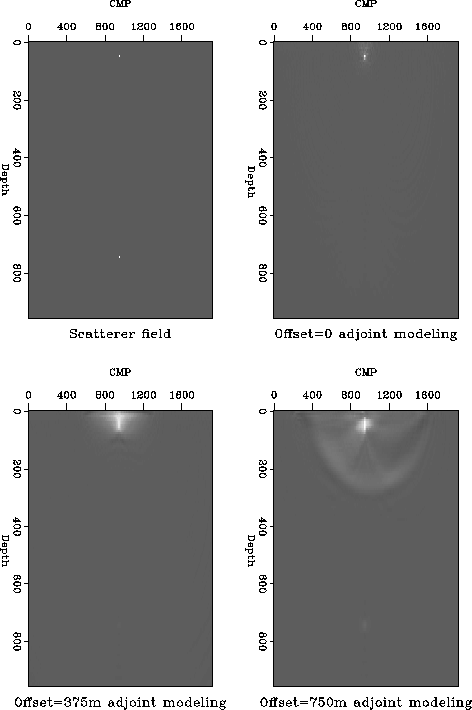Migration is often considered to be the adjoint of modeling, this would suggest the following adjoint operation as a reasonable constant offset imaging operation.
![]()
When I apply this process to the result of constant offset modeling
the result is very disappointing. Figure ![[*]](http://sepwww.stanford.edu/latex2html/cross_ref_motif.gif) shows the
result of adjoint modeling on the three constant offset panels shown
in figure
shows the
result of adjoint modeling on the three constant offset panels shown
in figure ![[*]](http://sepwww.stanford.edu/latex2html/cross_ref_motif.gif) . The deeper event has been imaged with such
a small amplitude that it isn't even visible. This is because the
Green's function I am using are not merely kinematically correct they
also have the correct amplitudes. The adjoint operation correctly
inverts the phase but is squares the amplitude. This would not be a
problem if the integration had been applied over infinite space and
time. The truncation of the modeling and adjoint modeling operators
results in a loss of energy from the image. The loss of energy is
greatest at the bottom of the section where only a small piece of the
hyperbola will be imaged.
. The deeper event has been imaged with such
a small amplitude that it isn't even visible. This is because the
Green's function I am using are not merely kinematically correct they
also have the correct amplitudes. The adjoint operation correctly
inverts the phase but is squares the amplitude. This would not be a
problem if the integration had been applied over infinite space and
time. The truncation of the modeling and adjoint modeling operators
results in a loss of energy from the image. The loss of energy is
greatest at the bottom of the section where only a small piece of the
hyperbola will be imaged.
 |
One way to overcome this problems is to apply a time dependent gain before the migration. This will amplify events that are later in time so that the amplitudes of the images of deeper events will be increased. However it will also increase the amplitude of the later parts of hyperbolas belonging to shallow events, this is not desirable. What should really be applied is a depth dependent gain after migration. Many authors, e.g. Lumley and Beydoun (1991), attempt to account for the effects of truncation by dividing by a ``diagonal Hessian'' operator, this is an approximation to the full inversion of the modeling operator. This process is often called ``migration inversion.'' In a V(z) medium this becomes a depth and offset dependent scaling after migration.